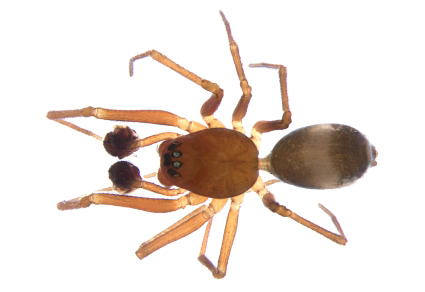Abstract
Agyneta hum Cajade, Rodrigues & Simó n. sp. and Agyneta unguiserrata Cajade n. sp. are described and illustrated from Brazil and Uruguay based on males and females. Males of A. hum differ from the related A. adami (Millidge 1991) by having apical and posterior pocket of paracymbium, presence of dorsal tibial apophysis and the shape and surface of the cymbial tubercles. Females of A. hum differ from A. adami in having the margins of the proximal part of the scape parallel and the presence of a pit hook depression. Males of A. unguiserrata distinguished from all other congeners by having a dorsal tibial apophysis claw-shaped with denticles on the retrolateral margin. Females of A. unguiserrata distinguished from all other congeners by the presence of two elliptical processes in the epigynum. Illustrations of somatic and genital characters and distribution maps of the species are provided. These species constitute the first report of the genus for Uruguay.
References
- Álvarez-Padilla, F. & Hormiga, G. (2007) A protocol for digesting internal soft tissues and mounting spiders for scanning electron microscopy. Journal of Arachnology, 35, 538–542. https://doi.org/10.1636/Sh06-55.1
- Cajade, M., Laborda, Á., Hagopián, D. & Simó, M. (2023) The spider genus Pseudotyphistes (Araneae, Linyphiidae) in Uruguay: a new species and new records. Zootaxa, 5284 (2), 390–396. https://doi.org/10.11646/zootaxa.5284.2.10
- Cala-Riquelme, F. (2021) Autodesk Sketchbook: An application that minimizes time and maximizes results of taxonomic drawing. Zootaxa, 4963 (3), 577–586. https://doi.org/10.11646/zootaxa.4963.3.10
- Dupérré, N. (2013) Taxonomic revision of the spider genera Agyneta and Tennesseellum (Araneae, Linyphiidae) of North America north of Mexico with a study of the embolic division within Micronetinae sensu Saaristo & Tanasevitch 1996. Zootaxa, 3674 (1), 1–189. https://doi.org/10.11646/zootaxa.3674.1.1
- Holm, A. (1979) A taxonomic study of European and East African species of the genera Pelecopsis and Trichopterna (Araneae, Linyphiidae), with descriptions of a new genus and two new species of Pelecopsis from Kenya. Zoologica Scripta, 8, 255–278. https://doi.org/10.1111/j.1463-6409.1979.tb00638.x
- Hormiga, G. (2000) Higher level phylogenetics of erigonine spiders (Araneae, Linyphiidae, Erigoninae). https://doi.org/10.5479/si.00810282.609
- Hull, J.E. (1911) Papers on spiders. Transactions of the Natural History Society of Northumberland, Durham, and Newcastle-upon-Tyne, (New Series) 3 (3), 573–590, pl. 15
- Koponen, S. (1994) Ground-living spiders, opilionids, and pseudoscorpions of peatlands in Quebec. The Memoirs of the Entomological Society of Canada, 126 (S169), 41–60. https://doi.org/10.4039/entm126169041-1
- Millidge, A.F. (1991) Further linyphiid spiders (Araneae) from South America. Bulletin of the AMNH, 205.
- Rodrigues, E.N.L., Brescovit, A.D., Freitas, G.C. & Vasconcelos, S.D. (2008) Spiders of Fernando de Noronha Island. Part I: Linyphiidae. Arachnology, 14 (5), 247–252. https://doi.org/10.13156/arac.2008.14.5.247
- Rodrigues, E.N.L., Lemos, Y. & Brescovit, A.D. (2013) A new species and new records of linyphiid spiders (Araneae: Linyphiidae) from Amazonas, Brazil. Zoologia (Curitiba), 30, 338–342. https://doi.org/10.1590/S1984-46702013000300013
- Saaristo, M.I. (1973) Taxonomical analysis of the type-species of Agyneta, Anomalaria, Meioneta, Aprolagus, and Syedrula (Araneae, Linyphiidae). Annales Zoologici Fennici, 10, 451–466.
- Saaristo, M.I. & Koponen, S. (1998) A review of northern Canadian Spiders of the genus Agyneta (Araneae: Linyphiidae), with descriptions of two new species. Canadian Journal of Zoology, 76 (3), 566–583. https://doi.org/10.1139/z97-217
- Shorthouse, D.P. (2010) SimpleMappr, an online tool to produce publication-quality point maps. Available from: https://www.simplemappr.net (Accessed 7 August 2023)
- WSC. World Spider Catalog (2023) World Spider Catalog. Version 24.5. Natural History Museum Bern. Available from: http://wsc.nmbe.ch (accessed 7 August 2023)


